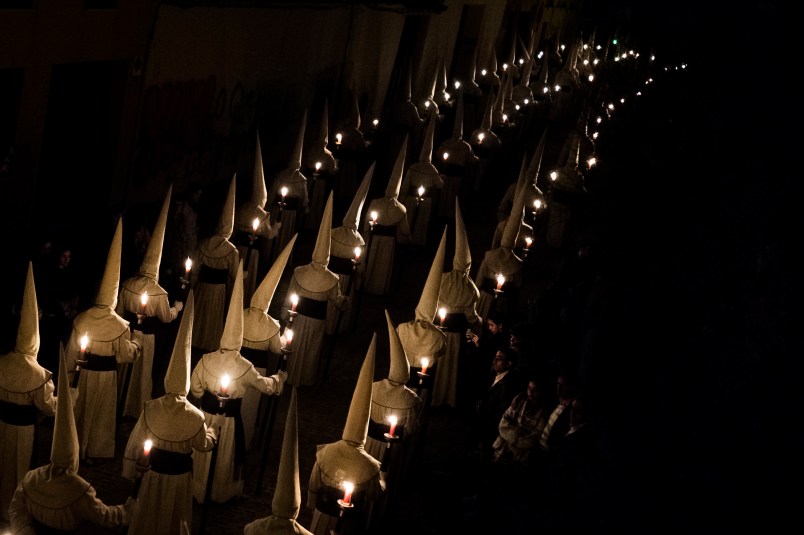I happened to see the photo above while reviewing AP images for another story. I was immediately struck by what – to American eyes – it cannot help but look like. The costume, color, hats, night-time procession all bring to mind the Ku Klux Klan. But it is something entirely different – these are penitents of the Jesus Yacente brotherhood taking part in Holy Week procession in Zamora, Spain, on Good Friday, one of hundreds of penitential processions that take place during Holy Week in Spain. Though not unique to it, religious brotherhoods and penitential processions are a particularly pronounced part of Iberian Catholicism, both in the Iberian Peninsula and in Latin America, the Phillipines and other parts of the world. The images are striking both for their inherent beauty and solemnity but also as an illustration of the unique emotive power certain imagery can take on in different cultures – jm.

Penitents of the Jesus Yacente brotherhood take part in a Holy Week procession in Zamora, Spain, Friday, April 3, 2015.

A penitent stands to listen a mass as he takes part in “La Carrera” procession by the ‘Vera Cruz’ brotherhood in Villarrin de Campos, Spain, Thursday, April 2, 2015.

Penitents take part in “Nuestro Senor Atado a la Columna, Maria Santisima de la Paz y San Juan Evangelista” Holy Week procession in Arcos de la Frontera, Spain, Tuesday, March 31, 2015.

A girl collects wax from a penitent large candle during the Holy Week procession of “Nuestro Senor Atado a la Columna, Maria Santisima de la Paz y San Juan Evangelista” in Arcos de la Frontera, Spain, Tuesday, March 31, 2015.

Penitents take part in “Santisimo Cristo del Perdon, Maria Santisima de la Piedad y San Juan Evangelista” Holy Week procession in Arcos de La Frontera, Spain, Wednesday, April 1, 2015 .

Hooded penitents from “El Calvario” brotherhood take part during a Holy Week procession in Cordoba, Spain, Wednesday, April 1, 2015.

Penitents talk as they take part in the a procession of “La Soledad” during the Holy Week in Madrid, Spain, Saturday, April 4, 2015.

Penitents prepare to take part in the procession of the “Exaltacion de La Santa Cruz” brotherhood, during Holy Week in Zaragoza, northern Spain, Thursday, April 2, 2015.

Penitents of the Jesus Yacente brotherhood take part in a Holy Week procession in Zamora, Spain, Friday, April 3, 2015.







Context has its uses. I was at an international scout camp in the mid 90s. When some Spanish members did something like this. It’s even more impressive at ground level as it were…
Haunting indeed. In the American context that costume means something utterly different than penitence.
I’m a fallen away Catholic but damn, we can do ritual.
Years ago when I was in high school, classes in Honors English in Florida required your family to purchase the books for some of the required readings. (nice public school system that makes students buy books). I found an old complete anthology of Shakspeare for a dollar at a used book store. It had swastikas as decoration inside the front and back cover. I also bought Crime and Punishment that was a poor English translation of the Russian names that I had to borrow the teacher’s book to separate the characters name.
I was shocked but the copyright date on the old Shakespeare book was 1909 which is long before Hitler and was not some type of symbol of Nazism. Still in 1976, I was very careful to read that book at home. The white Klan like robes reminds me of the swastika symbol.
Swastikas have been around for thousands of years. In buddhist images there are swastikas. Among Native American tribes the symbol was known. So a swastika could easily have been around in 1909 and have zero to do with the Nazis